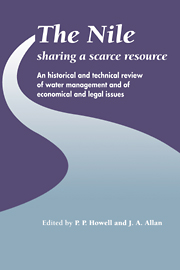 The Nile: Sharing a Scarce Resource
The Nile: Sharing a Scarce Resource Published online by Cambridge University Press: 05 February 2012
Introduction
Much of the current debate on the Nile and the distribution of its waters has centred on the recent shortfalls in Blue Nile flows owing to poor rainfall in the Ethiopian catchment and the possibility of this being a long-term or even permanent climatic feature. This and growing demand occasioned by population increase in Egypt and the Sudan naturally focuses attention on the potential of catchments other than that of the Blue Nile system and with which there is not necessarily any climatic correlation. High levels in Lake Victoria and increased discharges in the White Nile from the East African catchment during the last three decades and the possibility of increased rainfall in that area (see Chapter 6) therefore tend to reinforce interest in as yet very tentative schemes to reduce losses from evaporation and transpiration in the Sudd and neighbouring wetlands. These include the current Jonglei Canal Stage I now halted by the present civil war, and the projected Jonglei Canal Stage II, which will double the canal capacity.
There are also major canalisation schemes planned for two other swamplands where huge losses by evapo-transpiration occur, but neither of which draws its water from the White Nile catchment in East Africa. The first we refer to as the South-Western area, which includes the Bahr el Ghazal basin. This receives water from the Nile-Congo divide, virtually none of which ever reaches the Nile, and from rainfall which has no correlation with that from which the Bahr el Jebel and the Sudd derives.
To save this book to your Kindle, first ensure [email protected] is added to your Approved Personal Document E-mail List under your Personal Document Settings on the Manage Your Content and Devices page of your Amazon account. Then enter the ‘name’ part of your Kindle email address below. Find out more about saving to your Kindle.
Note you can select to save to either the @free.kindle.com or @kindle.com variations. ‘@free.kindle.com’ emails are free but can only be saved to your device when it is connected to wi-fi. ‘@kindle.com’ emails can be delivered even when you are not connected to wi-fi, but note that service fees apply.
Find out more about the Kindle Personal Document Service.
To save content items to your account, please confirm that you agree to abide by our usage policies. If this is the first time you use this feature, you will be asked to authorise Cambridge Core to connect with your account. Find out more about saving content to Dropbox.
To save content items to your account, please confirm that you agree to abide by our usage policies. If this is the first time you use this feature, you will be asked to authorise Cambridge Core to connect with your account. Find out more about saving content to Google Drive.